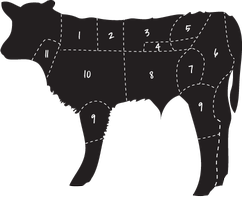
Veal cuts
Veal - tender and mild
- Young muscle, cartilage and bones produce great taste
- Hefty price for subtle flavors
- A fresh product that does not need to be tenderized
- Lean meat – prepare with care
- Less fat means shorter shelf life
The advantage with veal is that almost all pieces of the animal are tender and easy to cook. The muscling and bones are younger - and very tasty. The disadvantage is that you may need to pay quite a lot of money for not so much flavor.
From white to pink
Veal is slaughtered at an age of between four to five months. The whiter the meat, the more has the calf been raised on milk.
A calf that has started to eat grass and feed produces a more red meat and is sometimes called rosé veal. It does not have to be older than white veal, but it has a somewhat richer taste and the meat is slightly chewier.
Dark pink meat is probably not veal, but a half grown calf that is slaughtered at an age of six to seven months.
Careful cooking
The taste of veal is not as strong as that of a fully-grown animal, so be careful when seasoning.
It is better to slightly undercook vela, overcooking will result in dry and dull meat.
Veal is leaner than beef and loses large quantities of liquid – juiciness – when overcooked.
Veal contains a lot of protein, healthy minerals and very little fat.
Internal temperature for veal
Medium-rare, the center is lightly cooked. Internal temperature 50°C to 54°C.
Medium, the entire piece of meat has a pink interior. Internal temperature 54°C to 58°C.
Medium-well, only the center is pink. The internal temperature is 58°C to 65°C.
Well-done, grey meat. Internal temperature above 65°C
Don't tenderize
Veal is generally tenderer than beef and therefore takes a shorter time to prepare. Some pieces such as the fillet are so tender that they risk truning "mushy" if they are tenderized.
The hygiene factor
Since veal contains so little fat, it is more fragile than beef. As a guideline, large pieces stay fresh in the refrigerator for four to five days at the most, whereas small pieces should be consumed within three days, and minced and chopped meat within two days. Veal should be handled like chicken or pork from a hygiene point of view. You should rub the meat with a bit of olive oil to improve its durability and to retain the juicy interior.
For young animals, the breed is less important for the taste and character of the meat.
The reason veal is more expensive is the high quality of the meat, the high cost of raising the calfs and, simply, because the animal is younger and therefore produces a smaller amount of meat.
Cuts from a calf follow the same principles as fully-grown animals, with the only difference being that each part of the animal is smaller – with less developed muscles as a consequence – and the bones have a larger amount of soft cartilage.



















